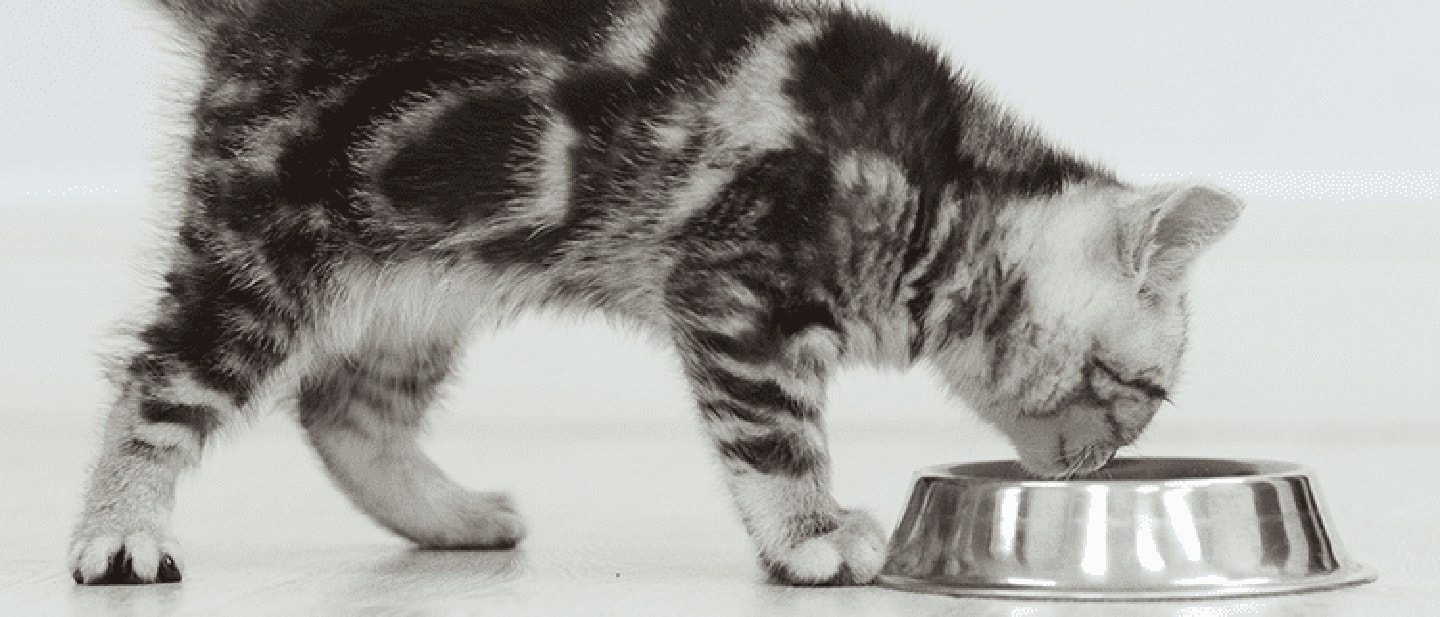
HOW MUCH TO FEED A KITTEN? KITTEN FEEDING GUIDE

Article checked by a vet
If you’ve recently brought home a new feline friend, or your cat has just given birth, you may be wondering how much to feed a kitten when it comes to weaning them in just a few weeks time! In the first few weeks and months of their lives, kittens are growing rapidly. You should feed your kitten food that has been specially formulated to be complete and balanced to meet the nutritional requirements of a kitten, served in small, regular meals throughout the day. In this kitten feeding guide, we discuss when kittens start eating as well as what and how much a kitten should eat.
Each kitten is different. Depending on their breed, their weight and size will vary and therefore the amount they eat will be marginally different. As kittens grow very quickly, you should feed your kitten food that is tailored to deliver all of the nutrients they need for healthy growth in each meal.
You can work out how much to feed a kitten by following the instructions on the back of your kitten food and adjusting accordingly for your kitten.
If your kitten is underweight, they may require more calories daily, in which case you could increase the number of meals offered throughout the day, so your kitten’s tiny stomach can consume little and often. If your kitten is overweight, you may need to reduce their daily calorie intake by slightly reducing the amount offered at each meal. Your vet can calculate how much you should feed your kitten based on the exact caloric amount your kitten requires, using the Body Condition Score to assess their weight.
Below is a kitten feeding guide you can use to understand how much to feed your kitten each day, although exact amounts will vary for your kitten.
| Age | Weight | Dry Food | Wet Food | Mixed Feeding |
| Up to 3 months | 0.5-1.7kg | 55g | 1 ½ pouch | 20g dry food + 1 ½ pouch |
| 4-5 months | 1.8-2.7kg | 60g | 2 pouches | 20g dry food + 2 pouches |
| 6-12 months | 3-4.5kg | 70g | 2 pouches | 30g dry food + 2 pouches |
It’s unlikely that you will overfeed a kitten.
Your kitten’s feeding schedule depends on their exact age. From when they’re newborn until 7 weeks, kittens drink their mother’s milk and nurse on demand. If their mother isn’t able to feed them, you should offer cat milk substitute formula in a small bottle around 8 times a day.
By 3 months, you can offer 4-5 meals across one day. Between 4-6 months, your kitten should eat a minimum of 3 meals per day. As they get closer to 1 year, you should feed your kitten a minimum of two meals per day. Your kitten may prefer more and can eat up to 6 times a day; you can discuss what’s best for your cat with your vet.
Kitten feeding methods
There are two main feeding schedules for kittens: free-feeding and meal-feeding. As a pet parent, it is up to you which you choose, although there are advantages and disadvantages of both to consider. It’s also important to check with your vet which kitten feeding schedule is suitable for your kitten, depending on their weight and nutritional needs.
Free feeding kittens
Free-feeding is when you leave food in your cat’s bowl so it’s available for your kitten to graze on throughout the day. This can only be done with dry food, as wet food will go off if left out for too long.
The benefits of free-feeding means your kitten can choose when to eat and learn self-regulation on how much they need to satisfy their hunger. This is also easier for owners who are busy with work and aren’t able to implement a feeding schedule for their kitten. However, if kittens aren’t able to self-regulate their food intake, there are health risks if they are overeating and becoming overweight.
It’s also difficult to free-feed if your home has multiple cats, especially older cats. Your older cat may try to eat your kitten’s food and exert dominance over them, leading to your kitten not eating enough and perhaps not feeling safe at home. If you choose to free-feed in a multiple-cat household, you can use a microchip-activated feeder which you can set up with your kitten’s microchip, so the dry food only dispenses for them.
Meal feeding kittens
Meal-feeding has more of a structure, and usually cats thrive off routine. It also works better if you are offering wet food. You can create a feeding schedule for your kitten by serving meals at specific times, such as morning, afternoon and evening. This will also help your cat become adjusted to expecting food at that time, stimulating their appetite enough to finish their meals. It’s also helpful for assessing how much to feed your kitten, if you have other cats too.
However, kittens require more meals per day than adult cats, so you need to make sure you’re able to serve as much food as they need. This method requires more time and structure for owners to follow, which can be difficult if you are working long hours.
The best feeding schedule for kittens is usually a combination of free-feeding and meal-feeding. You could leave dry food out for the day, whilst still offering wet food at mealtimes, to ensure your kitten doesn’t get hungry. We discuss more on the benefits of mixed feeding later.
There are also various cat feeding toys you can purchase which dispense dry kibble as your kitten plays around with it on the floor. Since hunting is instinctive in a cat’s nature, this is a great way to make mealtimes more exciting for your kitten, ensuring mental stimulation and physical exercise at the same time!
Whichever method you choose, the most important thing is that your cat is eating well. If your kitten is not eating, it’s important you take them to the vet immediately. Cats should not go longer than 24 hours without eating as they can get very sick, very quickly. This is especially dangerous for kittens who are more vulnerable. Usually, loss of appetite is a sign of illness or discomfort, which is why it’s essential to take your kitten to the vet. You can learn more about possible reasons your cat is not eating here.
So you know how often and how much to feed your kitten - now you’re wondering, what exactly should I feed my kitten? It’s essential you purchase high-quality food specific to kittens, as it contains the necessary nutrients for them to grow healthily. PERFECT FIT™ Kitten Junior<1 Complete Dry Cat Food has been approved by experienced vets at Waltham Petcare Science Institute, ensuring a healthy, balanced diet for your growing kitten.
When choosing kitten food, it’s essential to look out for high protein, calcium and fatty acid content. Protein is essential for a kitten’s developing body, as well as their playful energy, whilst calcium provides support to your kitten’s bones and teeth. DHA is the fatty acid to look out for, as it supports your cat’s nervous system, as well as the development of their brain and vision. Your kitten requires a lot of calories compared to adult cats, which is why kitten food is the best option.
You can also speak to your vet to see what is best for your kitten. Before we dive into the benefits of wet and dry food, let’s understand what’s going on in your kitten’s mouth.
Like human babies, kittens are born without teeth. At just 3 weeks old, your kitten’s milk teeth will start erupting through their gums. Then, at 12 -14 weeks old, these milk teeth will begin to fall out as they are replaced by the adult teeth. Kittens will have a full set of adult teeth by the time they are 6-7 months old.
This is part of why wet kitten food is usually easier for kittens to eat, and ensures they stay hydrated due to its high-moisture content. However, kittens can eat dry food from 3 weeks old, especially if you make it softer by mixing it with warm water, which also warms the food slightly and helps bring out its aromas (and your kitten’s appetite!). Dry kitten food is easier to feed, doesn’t go off if left out, and has great dental benefits for kittens, such as removing plaque.
Mixed feeding is when you offer a combination of both wet and dry food. By serving both types of food to your kitten, you’re expanding their palate and encouraging them to try different foods. This helps as your cat gets older, as they are less likely to be fussy eaters and more accepting of new foods. We’ve created a kitten feeding guide on the art of mixed feeding to help you.
Certain human foods can be toxic to cats, so below is a list of some foods you can and cannot offer, to protect your kitten.
Can eat:
- Plain cooked fish - such as tuna, mackerel, salmon
- Plain cooked chicken - skin and bones removed
- Plain cooked meat - beef, turkey, lamb
Cannot eat:
- Raw eggs, chicken or meat
- Onions and garlic
- Cow’s milk or cream
- Grapes and raisins
- Dog food - incomplete nutrients
- Chocolate
- Caffeine or alcohol
When kittens are born, they nurse from their mother until 8 weeks old, when the mother’s milk begins to dry up. However, from 2 weeks old kitten’s baby teeth begin to appear, and by 3-4 weeks your kitten can start eating solid foods.
You can learn more about the development of kittens into cats and their changing needs. PERFECT FIT™ Adult Chicken Dry is an excellent food for kittens to transition to once they’re adults, and you can learn how to switch cat food safely and successfully.
Whilst nutrition is a huge part of a kitten’s development, it’s important you also support their needs around play, hunting and sleep. Find out how much sleep your kitten needs to understand their sleeping habits. Spoiler alert: kittens sleep a lot.
